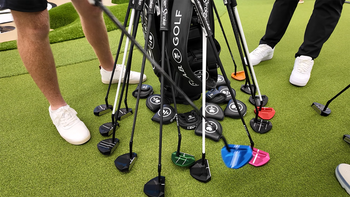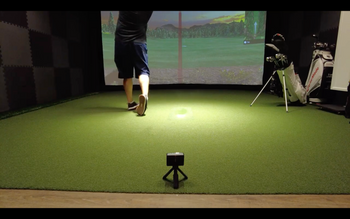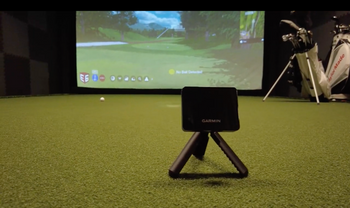So you're torn between dropping five grand on either the Garmin R50 or Uneekor Eye Mini? Yeah, I get it - that's a serious chunk of change for a launch monitor. Let me break down what I've learned after testing both of these bad boys extensively.
Here's the deal - you're looking at two premium launch monitors that'll run you about $5,000 each. They're targeting golfers like us who want tour-level data without selling a kidney. Both pack serious tech into portable packages with built-in screens, and they'll track everything from ball speed to spin axis without needing extra sensors on your clubs.
Think of it this way: these units are like having a personal TrackMan that won't require a second mortgage. You get instant feedback on every swing, whether you're grinding at the range or building a home simulator setup.
Now, I'm gonna score these head-to-head in ten key areas using a simple 0-5 rating system. We'll look at everything from what it's like ripping open the box to how much those pesky annual fees will sting your wallet.
Here's what matters: cost comparison, that exciting unboxing moment, how quickly you'll be hitting shots, whether you can actually lug it around, accuracy of the numbers, performance under the sun, simulator capabilities when it's nasty outside, cool features that actually help your game, software for virtual rounds, and those ongoing subscription fees that nobody talks about upfront.
The million-dollar question (well, five-thousand-dollar question) is whether the R50 and Eye Mini are basically twins or if one clearly outshines the other. More importantly, which one deserves a spot in your golf setup?
Let's dig into the nitty-gritty and figure out which launch monitor will actually help you break 80 - or at least stop slicing it into the next fairway.
Table of Contents
Key Features
Built-in Display Technology: The Garmin Approach R50 features a stunning 10-inch built-in color touchscreen display that functions like having an iPad attached to your launch monitor. This eliminates the need for external devices and provides immediate access to shot data, impact videos, and course play. The SkyTrak Plus, in contrast, requires connection to external devices like smartphones, tablets, or computers for data visualization and gameplay.
Camera and Tracking Systems: The R50 utilizes a sophisticated three-camera system that captures comprehensive ball and club metrics, tracking over 15 different data points including measured spin rate and spin axis. The SkyTrak Plus employs advanced dual Doppler radar technology combined with high-speed photometric cameras, providing over 20 ball and club data points including club head speed, smash factor, club path, and face angle.
Setup Requirements and Accessories: The Garmin R50 requires club stickers (250 included) to track club data metrics, which need to be applied to club faces for optimal performance. The SkyTrak Plus operates without any special balls or club stickers, offering a more streamlined setup process with no additional accessories needed for full functionality.
SkyTrak+ Launch Monitor
SkyTrak+ delivers pro-level launch data and simulation for golfers serious about improvement.
Distinct Advantages
You're looking at dropping $4,500 on the Uneekor Eye Mini versus $4,999.99 for the Garmin Approach R50. Yeah, that's serious cash – we're talking about a nice vacation or a year's worth of greens fees at your local muni.
Here's where it gets interesting, though. That extra $500 for the R50? You're actually getting your money's worth when you dig into what this thing can do. We're talking about features that'll have you understanding your swing like never before.
Both units give you the full meal deal – ball speed, spin rates, launch angles, the works. And here's what I love: neither company locks their data behind some annoying subscription fee. You buy it, you own all the features. That's refreshing in today's nickel-and-dime world.
Now let's be real for a second. Five grand is a chunk of change, and there are launch monitors out there for under a thousand bucks that'll tell you most of what you need to know. They won't give you the precision or all the bells and whistles of these premium units, but if you're just trying to dial in your distances or work on consistency, they might be all you need.
The R50 and Eye Mini? These are for when you're serious about taking your game up a notch. Think of it like upgrading from your buddy's hand-me-down clubs to a custom-fitted set. Sure, you can play with either, but one's gonna help you shoot lower scores more consistently.
Bottom line: If you've got the budget and you're committed to improvement, either one's a solid investment. Just depends on whether those extra R50 features are worth the additional five hundred to you.
Garmin R50 Launch Monitor
Garmin R50 revolutionizes practice with the world’s first all-in-one portable launch monitor and simulator.
First Look – Unboxing Experience and Initial Thoughts
You know how some golf gear just screams quality the second you unbox it? That's exactly what happens with the Garmin Approach R50 and Uneekor Eye Mini launch monitors.
Let me tell you about the R50 first. When you crack open that box, your jaw's gonna drop. This thing is a beast – we're talking 17 inches tall, a foot wide, and it tips the scales at 9 pounds. But here's the kicker: once you fire it up, that 10-inch screen lights up like a Vegas marquee. The colors pop so much you'll forget you're looking at golf data instead of watching the Masters in 4K.
Now the Eye Mini takes a different approach. Think of it as the muscle car of launch monitors – compact but built like it could survive a tornado. At just under 16 inches tall and 8 pounds, it's got this bulletproof construction that makes you feel like you're investing in something that'll outlast your golf career. Everything about it whispers premium quality instead of shouting it.
Here's where both units really flex: their carrying cases. The R50 rolls with what I'd describe as a luxury cooler on steroids – massive but built to protect your investment. It's got a shoulder strap, which you'll need because hauling this setup to the range isn't exactly like carrying a dozen Pro V1s.
The Eye Mini's case? Picture the nicest piece of luggage you've ever seen, but in this killer olive green color that looks like it belongs in a tour pro's trunk. Both cases have custom-molded padding that cradles these monitors like newborns. You could probably drop-kick either case down your driveway (not recommended!) and the monitors would be fine.
Look, I get it – spending serious cash on launch monitor tech feels like a big leap. But when companies nail the presentation this hard, it tells you they're not cutting corners anywhere else. These aren't just pretty faces either – they're legit game-improvement tools wrapped in packages that make you excited to practice.
Setup Simplicity – Garmin R50 Compared to Eye Mini
You know what's wild? The Garmin Approach R50 makes every other launch monitor look like they're stuck in the Stone Age when it comes to getting up and running. We're talking power button to tracking shots in under 60 seconds - that's faster than waiting for your playing partner to line up their putt.
Here's the deal: This thing runs on a gorgeous 10-inch touchscreen that shows everything you need without connecting to your phone, tablet, or computer. Your ball speed, launch angle, spin rate - it's all right there on a display that's clearer than your TV at home. And when do you want to see your shots on the big screen? Just plug in an HDMI cable directly to your projector. No complicated setup, no extra computers needed.
What really sets this bad boy apart is that it's got Home Tee Hero simulator software built right in. You're basically getting a launch monitor and golf simulator in one package - no other device pulls this off. Want to play Pebble Beach in your garage on a rainy Saturday? You're already good to go without buying anything else.
Now, heads up - the Uneekor Eye Mini has its own screen too, which is pretty convenient. But here's where it gets tricky: that screen only shows you basic stuff. You'll see maybe 10 data points max, and if you want the full breakdown of your swing or to watch your ball flight, you're back to connecting iPads or computers. It's like having a sports car that only shows you the speedometer when you really want to see all the gauges.
The R50 gives you instant feedback that actually helps your game. You'll see exactly why that drive sliced into the woods (too much sidespin, buddy) or why your 7-iron came up short (lower launch angle than you thought). Having all this info right at your fingertips means you can make adjustments on the spot instead of guessing what went wrong.
Look, if you're serious about improving and don't want to deal with tech headaches every time you practice, the R50 is your ticket. Sure, it's an investment, but you're getting professional-level data without the professional-level complexity. Your 15-handicap game will thank you when you start hitting more greens because you finally know your real distances.
On-the-Go Golf Tech – Portability Face-Off
Let's talk portability – because honestly, you're gonna want to take these things places. Look, I'll be straight with you: neither one fits in your back pocket. We're talking serious gear here, not your phone app.
The Eye Mini takes this round, though. Itsa a travel case? Way more manageable. You can actually toss it in your trunk and head to the range without feeling like you're moving furniture. That's huge when you're trying to squeeze in practice between work and that 9-hole twilight round.
Now here's where things get interesting with the R50. This bad boy is completely self-contained – no laptop, no iPad, nothing else needed. Just the unit itself. Think about that for a second. You could literally set up shop in your garage with just a hitting mat and net. Want to work on your swing at your buddy's place? Done. Got 10 feet of space in your basement? You're golden. Hell, throw up a net in the backyard and you've got yourself a practice facility.
The R50's setup flexibility is honestly mind-blowing. While other launch monitors have you juggling devices and cables, this thing just works wherever you've got room to take a swing. That's a game-changer for those of us who practice at weird hours or don't live near a range.
Still, when it comes down to pure "grab and go" convenience, the Eye Mini's smaller footprint makes it the winner. Sometimes you just need something that doesn't feel like you're lugging around a piece of furniture, you know?

Data Insights – Performance Metrics Compared
You've probably heard golf buddies argue about whether launch monitors are worth the investment. Well, here's the deal with two options that'll give you tour-level data without breaking the bank.
Both the R50 and Eye Mini serve up every stat you'd want - we're talking launch angles, spin rates, club path, the whole nine yards. No hidden fees or subscriptions needed to unlock the good stuff.
Here's where things get interesting, though. The R50 puts everything right there on its built-in display. You're getting instant feedback on your swing without fumbling with extra devices. The Eye Mini? It shows you 10 key stats on the unit itself. Want the full breakdown? You'll need to connect your iPad or laptop.
The tech behind these units matters too. Picture this - the R50 watches your swing with three high-speed cameras tracking every millisecond of impact. That third camera makes a difference. The Eye Mini runs on two cameras, which still beats most units out there, but when you're trying to figure out why your 7-iron keeps fading, that extra camera eye on the R50 catches details others might miss.
You're getting bombarded with numbers either way. The R50 tracks 18 different metrics - everything from your smash factor (how efficiently you're transferring energy to the ball) to your face-to-path relationship (why you're hitting that annoying slice). It'll tell you exactly how many yards offline you landed and whether your attack angle needs work.
The Eye Mini covers all the essentials, plus some extras like flight time and distance to apex - basically how long your ball hangs in the air and when it peaks. You'll see your carry versus roll distances, which really helps when you're deciding between clubs on approach shots.
Both units nail the fundamentals that weekend warriors actually need. Your clubhead speed tells you if those new shafts are helping. Ball speed and launch angle show whether you're compressing the ball properly. Spin rates reveal why your drives balloon in the wind.
The accuracy difference between them? Think of it like comparing a really good rangefinder to a tour-grade one. The Eye Mini gets you close enough to make real improvements. The R50 just adds that extra confidence when you're analyzing your numbers.
If you practice at home or want instant feedback without tech hassles, the R50's built-in screen changes the game. But if you're already comfortable using tablets for golf apps and want to save some cash, the Eye Mini delivers the goods.
Either way, you're getting data that used to require a trip to a high-end fitting studio. Now you can diagnose that push-fade in your garage and actually fix it before your next round.
Taking Your Game Outdoors – Field Testing
You know what's wild about the Garmin Approach R50? You can literally set this thing up in your backyard and be playing Pebble Beach in under sixty seconds. No laptop needed, no cables, nothing. Just fire it up and you're good to go.
Think about it - you've got over 43,000 courses loaded right into the unit. The screen shows everything happening with your shots, from launch angle to spin rates. Setting it up is stupid simple, too. My buddy, who struggles with his smartphone, never figured out the alignment in like two minutes.
Here's the catch, though - you're not throwing this bad boy in your golf bag. The thing's built like a tank, which is great for durability, but it's definitely more of a "load it in the trunk" situation. The carrying case alone is bigger than most stand bags.
Now the Uneekor Eye Mini plays in the same sandbox. It's got its own screen too, so you can see your numbers instantly when you're crushing balls at the range. No squinting at your phone or dragging a laptop around.
Where it gets tricky is that you're only seeing ten data points on that built-in screen. Want to see your actual ball flight path? You'll need to hook up an iPad or computer. It's like getting the appetizer but needing to order separately for the main course.
Same story if you want to play virtual rounds. The Eye Mini can't do simulator golf on its own - you need external devices for that. Before the R50 showed up, every launch monitor worked this way, so it's not like Uneekor dropped the ball. They just didn't push the envelope like Garmin did.
Both units are too hefty for your golf bag, but that's the trade-off for getting tour-level accuracy. You're basically getting the same tech the pros use to dial in their distances, just in a more portable package than the $25,000 monsters at your local golf shop.
SkyTrak+ Launch Monitor
SkyTrak+ delivers pro-level launch data and simulation for golfers serious about improvement.
Indoor Golfing Experience – Eye Mini vs R50
You know what's wild about the Garmin Approach R50? It's literally the only launch monitor you can plop down anywhere and start hitting balls without needing anything else. Your garage, the range, hell, even your buddy's backyard - this thing just works wherever you set it up.
Setting up a home simulator gets ridiculously easy with the R5,0, too. Want to project your shot onto that screen you just hung up? Just grab an HDMI cable and plug it straight into your projector. No laptop, no complicated software setup, nothing. Compare that to hauling a whole computer setup to your friend's place when they want to try it out - the R50 wins every time.
Here's the cat, ch though - if you're dreaming about playing Pebble Beach on GSPro or other fancy sim software, you'll still need a computer hooked up. The built-in Home Tee Hero gets you started, but for the full simulator experience, the R50 works just like every other launch monitor out there.
The Uneekor Eye Mini takes a different approach. Since it sits beside your ball instead of behind you (just like the R50), you won't need a massive room to use it. That's clutch if you're working with a tight space where every foot counts.
Where things get tricky with the Eye Mini is that you absolutely need a computer for everything, even just to see where your ball went. Want to play a round on the sim or hook it up to your TV? That computer becomes the middleman for everything you do.
Don't get me wrong, the Eye Mini still gives you solid performance, and it's not exactly complicated to use. But when you compare the plug-and-play simplicity of the R50 to needing a full computer setup every single time with the Eye Mini, there's a clear winner in the convenience department.
Garmin R50 Launch Monitor
Garmin R50 revolutionizes practice with the world’s first all-in-one portable launch monitor and simulator.
Feature Highlights – What Sets Each Apart
You know that feeling when you walk into the Apple store and see the latest tech? That's exactly what hitting balls with the Garmin Approach R50 feels like. This thing's packed with features that'll make your jaw drop - and your golf game better.
First off, forget squinting at tiny screens. The R50 rocks a 10-inch color touchscreen that's basically an iPad built right into your launch monitor. You're getting crystal-clear data that you can actually see without pulling out your reading glasses. Plus, it responds to your touch just like your phone does - no frustrating lag or missed taps.
Here's where it gets really cool: you can plug this bad boy straight into your TV or projector with an HDMI cable. Think about that for a second. You're transforming your garage into a legitimate golf studio without needing
Golf Simulator Performance – Eye Mini vs Garmin Approach R50
Let's talk about how both these launch monitors handle simulator play - this is where things get really interesting for your home setup.
The Garmin R50 scores big here. You've got Home Tee Hero built right into the unit, so you can fire it up and play virtual rounds without needing anything else. Sure, it's not quite as slick as GSPro's graphics, but Garmin really stepped up its game compared to what you'd get on the cheaper R10. The courses actually look like real golf courses now, not some video game from 2005.
Want to level up your Sim experience? The R50 plays nicely with all the heavy hitters - GSPro, E6 Connect, E6 Apex, and Awesome Golf. You'll need to hook up a computer for these, but here's the kicker - Garmin doesn't charge you extra subscription fees to use them. That's money staying in your pocket for green fees or new balls.
Now the Eye Mini handles third-party software too. You can run E6, GSPro, Awesome Golf, and The Golf Club 2019. But hold up - Uneekor wants another $199 every year for their Pro Package just to connect to these programs. That's like paying for a country club membership on top of buying the clubs.
As for Uneekor's own simulator software called Refine? It's decent enough. You won't hate it, but you won't be blown away either. Think of it like the difference between your local muni and a top-tier course - it gets the job done, but you know there's better out there.
Bottom line: if you're planning to use your launch monitor for winter practice or rainy day rounds, the R50 gives you way more flexibility without nickel-and-diming you on subscriptions. The Eye Mini makes you pay to play with the software you actually want to use.
Ongoing Costs – Subscriptions and Extras Explained
Look, both of these launch monitors give you the good stuff right out of the box - all your ball flight numbers and club data without nickel-and-diming you. That's pretty sweet if you're just looking to dial in your distances and work on consistency at the range.
But here's where things get interesting when you're ready to take virtual swings at Pebble Beach from your garage. The R50 actually saves you some cash in the long run. You can hook it up to whatever SIM software you want without Garmin hitting you with an extra connection fee. Sure, you'll still shell out for the actual software, but at least it's not a double whammy on your wallet.
Now, if you're sticking with Garmin's built-in Home Tee Hero courses (which are way better than what came with the old R10, by the way), you're looking at ten bucks monthly or a hundred for the whole year. Not too shabby.
The Eye Mini? Man, that's where your beer money starts disappearing. You're dropping two hundred bones every year just to unlock any simulator features at all. Want to use Uneekor's own Refine software? Pay up. Want to connect to other SIM programs? Same deal - plus whatever those programs cost on top.
And get this - that $199 yearly fee only gets you five measly courses on Refine. If you want the full spread of twenty courses with Refine+, you're talking four hundred bucks a year for their Champion tier. That's getting into country club membership territory, and you're still playing in your basement!

Frequently Asked Questions
What are the key differences in data tracking between the Garmin Approach R50 and Uneekor Eye Mini?
The Garmin Approach R50 provides all data metrics directly on its built-in touchscreen, including over 15 ball and club metrics, using a three-camera system. The Uneekor Eye Mini offers 10 core data points on its integrated e-ink display, but to access the full suite of 19+ metrics, you need to connect to external software via an iPad or PC. The R50 is generally considered to provide slightly more comprehensive and immediately accessible data.
How easy are these devices to set up and use?
The Garmin Approach R50 is known for its extremely simple and fast setup—less than a minute from power-on to play, with all features available on the device itself. The Uneekor Eye Mini is also portable and quick to set up, with instant feedback on its display, but full functionality (like shot trajectory visualization) requires connecting to additional devices and software.
Can both launch monitors be used indoors and outdoors?
Yes, both the Garmin Approach R50 and Uneekor Eye Mini are designed for indoor and outdoor use, making them versatile for home simulators or driving range practice.
What are the display features of each device?
The Garmin Approach R50 features a 10-inch color touchscreen that displays all metrics, shot trajectories, and simulator functions. The Uneekor Eye Mini has an integrated e-ink display for instant shot data, but requires external devices for more advanced visualization and simulator play.
Which device is more portable and travel-friendly?
Both devices are highly portable and come with robust carrying cases. The Eye Mini is slightly lighter and more compact, while the R50’s case is larger but also highly protective. Both are suitable for travel and quick setup in various locations.
Conclusion
You've gotta hand it to Uneekor - their Eye Mini launch monitor is solid as a rock. The thing pumps out more data than you'd know what to do with, and it's built like a tank.
Here's the thing, though - once you stack it up against the Garmin R50, it's fighting an uphill battle. And honestly? At this price level, everything else is too. Garmin basically rewrote the playbook with the R50. We're talking about the first launch monitor that gives you the whole enchilada - tracking your shots AND running simulator software without needing extra gear.
Let me break it down for you. Sure, you're dropping an extra five hundred bucks on the R50 compared to the Eye Mini. But when you look at everything packed into that unit versus what you're getting with Uneekor? The math actually works out in Garmin's favor. You're getting way more bang for your buck.
Don't get me wrong - these two units share some DNA. But the R50 brings so much extra to the table that it's not even a fair fight. If you're serious about dialing in your game and want something that'll grow with you as you improve, the smart money's on the Garmin.
Bottom line? The R50 takes this matchup without breaking a sweat.







